Keeping Membership Data up to Date
Lighthouse Training - Module 8
Time estimate: 11 minutes
Topics: Lighthouse, Lib Dem systems and tools
Beyond basic membership information, there is a lot of data HQ relies on local parties to keep up to date. Often, as you will be in direct contact with members, you will be the only person a member tells about change in their information. On Lighthouse, it is quick and easy to keep everything up to date.
Lighthouse syncs with the federal membership database so, when you update a contact's information, HQ will be updated almost instantly.
Understanding contact preferences
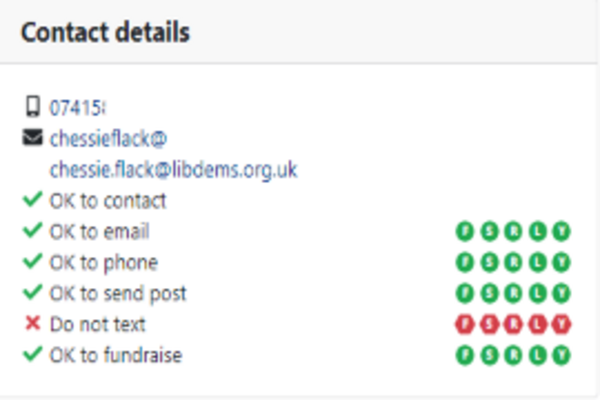
You can see a quick glance summary of who can contact a member and for what on a user’s contact record.
- F means the Federal Party can contact them using this method
- S means their State Party can contact them
- R means their Regional party can
- L means their local party can
The image to the right is of a member who has opted into receiving all allowed forms of communication.
This allows members to pick and choose who they want to hear from. It is absolutely essential that you respect the opt-in preferences that are in the system. If you think they’re wrong, then the member in question should be encouraged to email help@libdems.org.uk to update them.
You can also edit opt-in preferences for your level of access to Lighthouse (state, regional or local) but you should only do this if you have a documented request from the contact in question. If you need to change preferences for another part of the party you'll need to submit a problem report to do that.
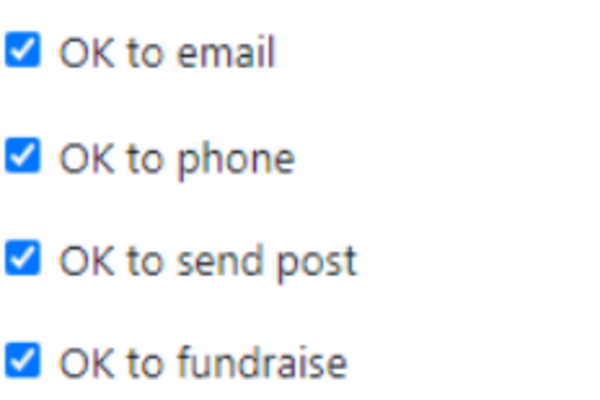
You can also edit opt-in preferences for your level of access to Lighthouse (state, regional or local) but you should only do this if you have a documented request from the contact in question. If you need to change preferences for another part of the party you'll need to submit a problem report to do that.
You can edit these preferences when you edit the contact. The options are at the bottom of the contact page.
Here’s a breakdown of what each item means:
- OK to contact: this tells you if a contact can be contacted. If this is crossed, the contact cannot be contacted by any means or for any reason
- OK to email: this tells you if a contact can receive bulk or marketing email. If this is crossed, you can still send them 1-to-1 emails about their membership lapsing - but not to do things like invite them to action days or ask for donations
- OK to phone: this tells you if you can call a contact on the phone. If this is crossed you cannot call them. This preference should be respected even if Connect says you can call as it is more likely to be accurate
- OK to send post: this tells you if a member can be sent post. If this is crossed you cannot send them post. This preference should be respected even if Connect says you can, as it is more likely to be accurate
- OK to text: this tells you if you are okay to send bulk text messages. Individual text messages may be sent even if this is crossed, but only if you follow the advice in the Whatsapp Guide, which can be found here.
This will currently be set to false on all contacts and be uneditable as there are no approved bulk texting suppliers - OK to fundraise: this tells you if you can ask a contact for money. If this is crossed, then you shouldn’t ask them to make a donation or loan, although inviting them to paid events would be okay.
This opt-in means if you’re sending a fundraising email and someone’s fundraising opt-in is a cross, you should not send them that email
Members who refuse to renew
Sadly, not all members want to renew their membership. But usually, all that happens is that they tell us, over and over and we keep sending them emails and calling them - and that’s not great for the member and it’s not great for you, who are working hard to contact members who are at risk.
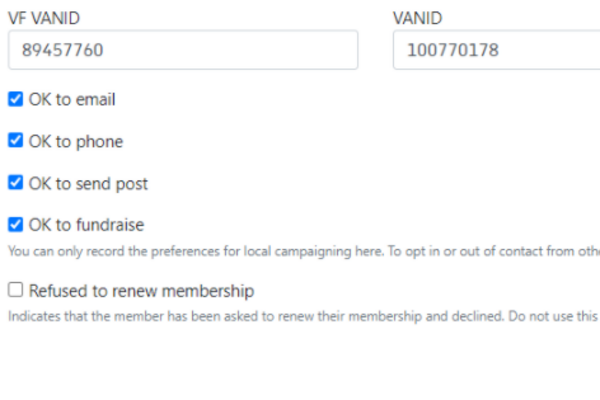
If a member tells you that they don’t want to renew, all you have to do is open their contact record, by clicking the eye icon by their name, and find the Membership information section. Then, tick the box next to “Refused to Renew” - and then hit “Update” - and you’re done!
The box will only appear if the member is at risk, as its function is to end renewal comms to the member, not end the membership or any membership payments.
The system then gets to work in the background. Once the box is checked, they’ll be removed from HQ’s lapsing lists and they’ll stop getting emails from us. They might get a letter after telling us, but if those are already in production, we can’t stop them.
You’ll still see the member in your At-Risk member views and exports until after they lapse - so make you remove people who’ve refused before you start making calls.
The lapse risk flag on their MyCampaign record will also be removed - although that can take up to 7 days.
If a member later changes their mind and renews or rejoins, the flag will be cleared on their profile.
Refused to renew opts members out of comms about renewing, and should not be used to try to resign a member. If a member tells you they want to resign over the phone, ask them to email help@libdems.org.uk with their request, and remind them their membership will remain active until they do this. If they email you the request, you can submit a problem (more on that later) and attach the written request.
Marking members as unknown at address
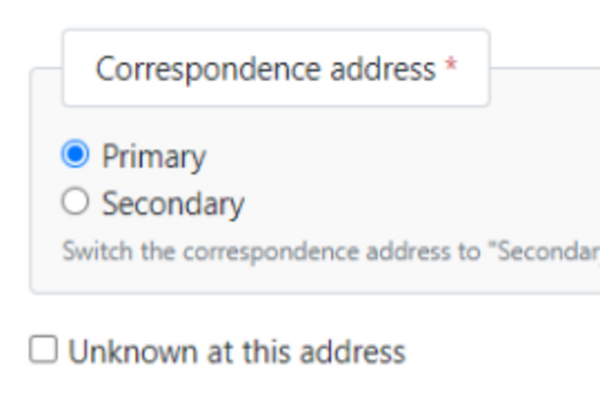
Sometimes members or contacts move and don’t let us know their new address. You might notice that they have disappeared from Connect, but are still showing on Lighthouse, or you have had some mail returned from them.
When this happens, you can mark them as ‘unknown at this address’.
You will need to select their contact and click ‘edit’. Underneath the ‘correspondence address’ box, you will see a tick box called ‘unknown at this address’.
Click this and then click update in the bottom right-hand corner.
When you do this, the contact will receive an email with a unique URL, through which they can update their address.
If a member contacts you and tells you they have moved, you can update their address, the same way you would make other edits to the contact.
If you don’t know their new address, you can send them a unique change of address link.
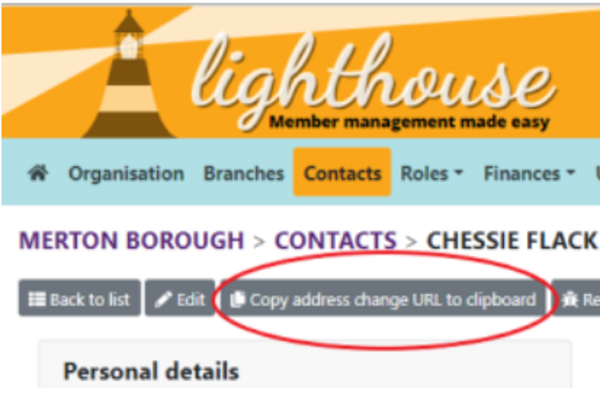
To find this link, you will need to click the eye icon to view the contact.
You will see a button at the top left of the page titled “Copy address change URL to clipboard”. Click this button, and your computer will take a copy of the link you need to send to the member in question, which you should then paste into an email to them.
After the member clicks on the URL, they will be directed to an online form, in which they can fill out their new address details. This will then automatically update their contact record in Lighthouse, meaning you do not need to do anything else!
Marking contacts as deceased
If you know a member has died, it is important you record this on Lighthouse, to ensure we don’t attempt to contact this member.
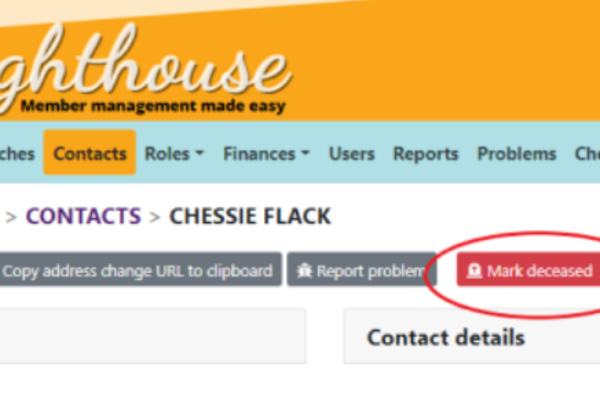
Once you have found the contact record for the deceased member, open their record by clicking on the eye icon. Then click the red button at the top of the profile labelled “mark deceased”.
Deceased contacts will remain in your contact list, but will be marked as ‘do not contact’.
Tasks
Tasks are quick and easy things you can do after each module to help practice what you've learned. Try them out and see if they help!
|
